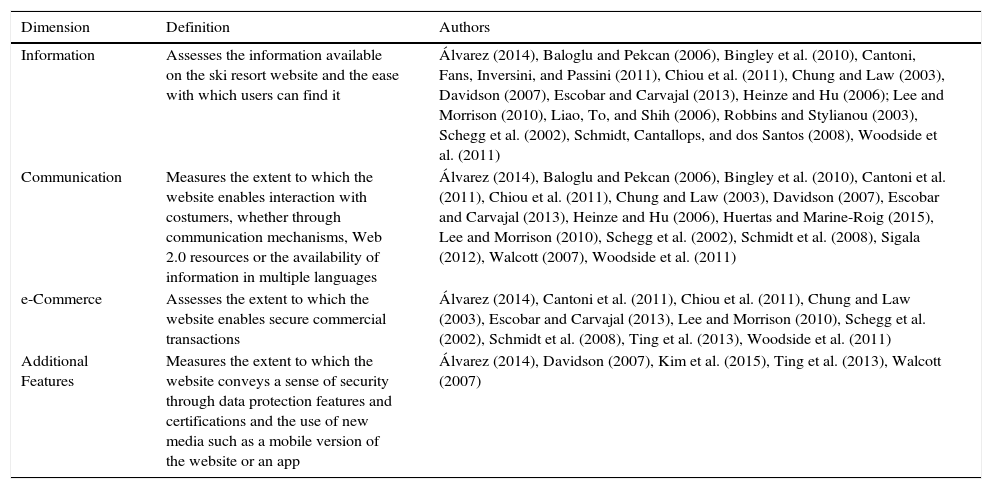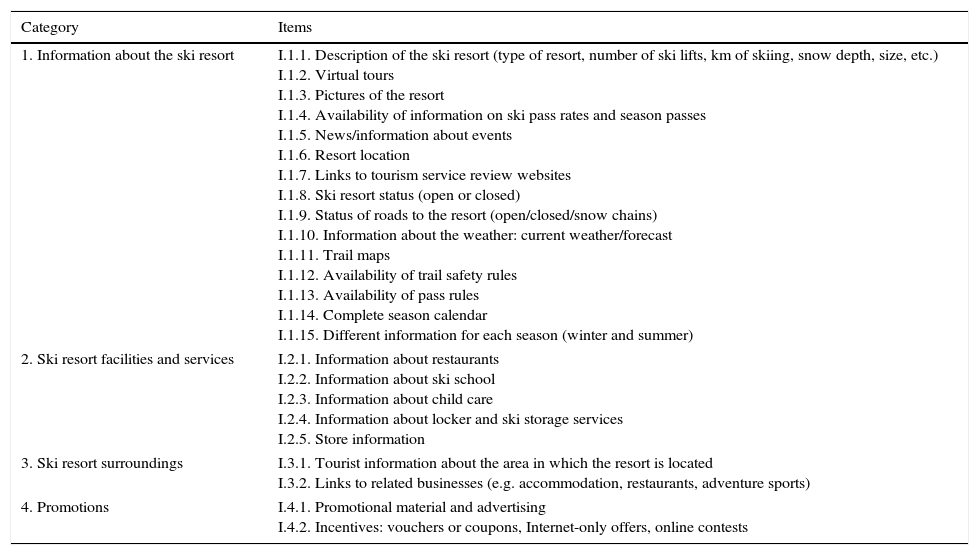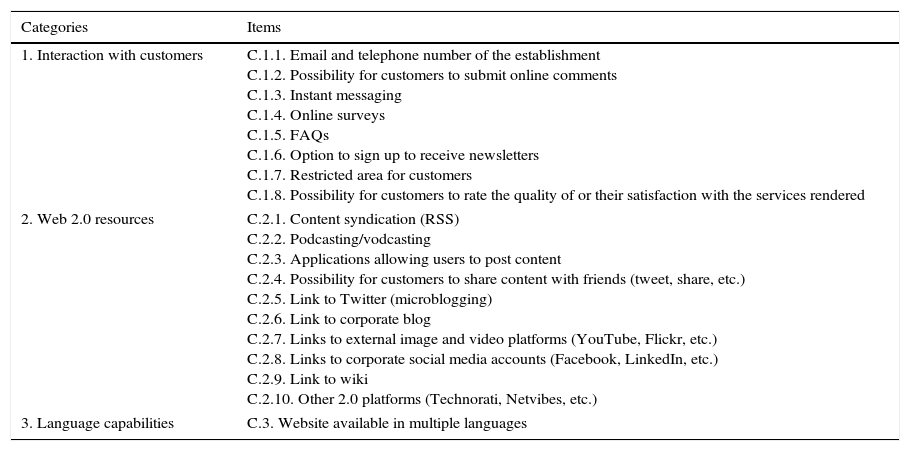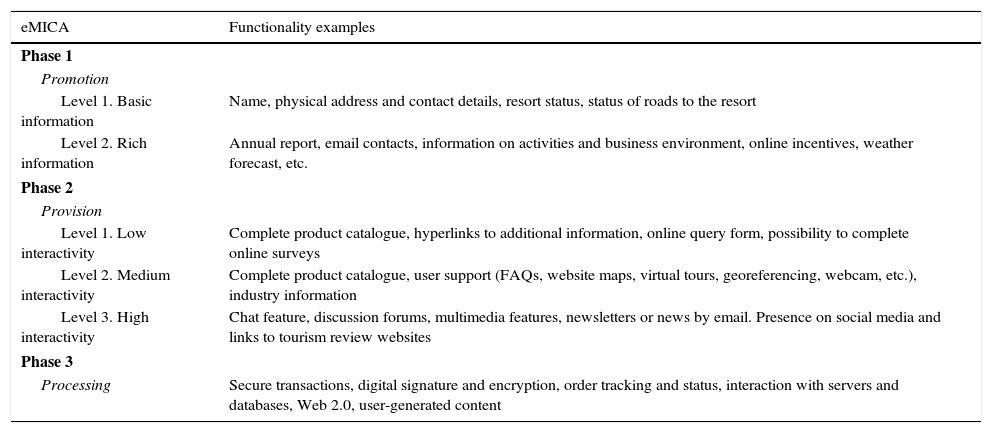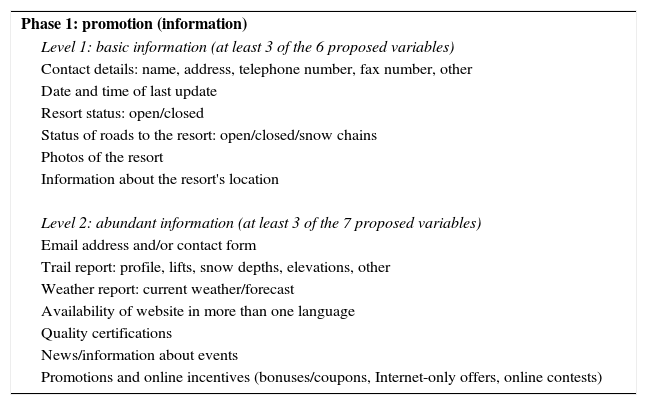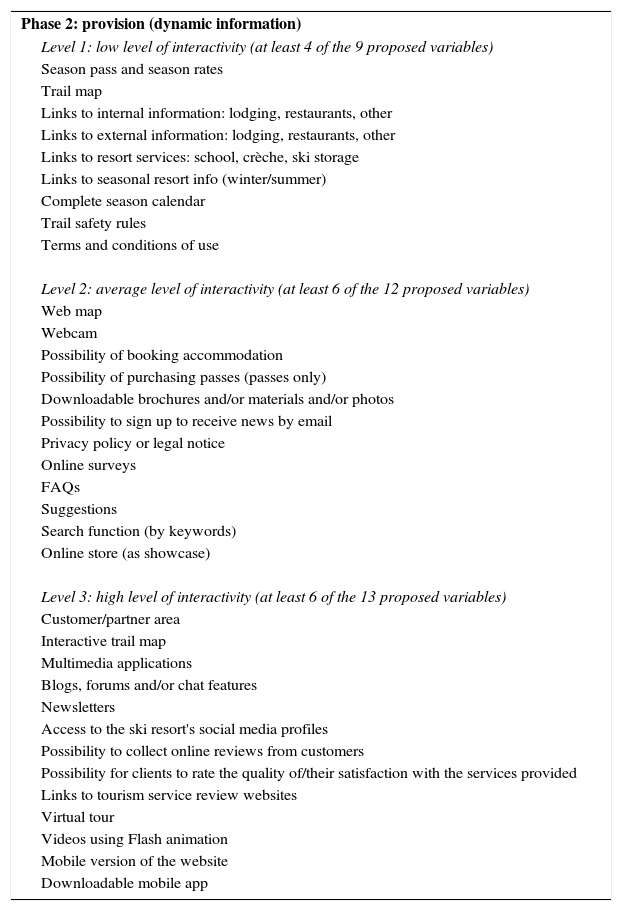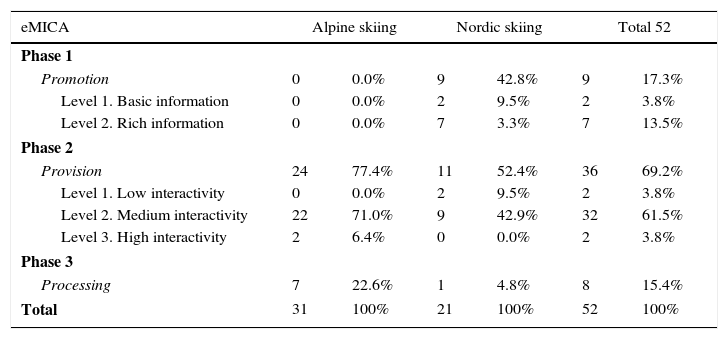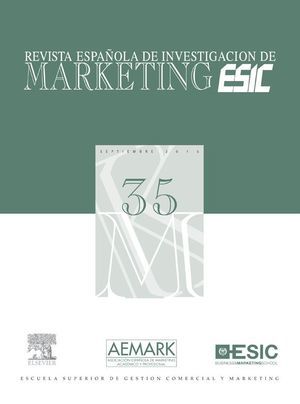This study sought to determine whether ski resort websites facilitate effective communication with their target audience and whether they are adapted to electronic commerce (e-commerce). To this end, first, a content analysis model was developed and applied to ski resort websites, considering four dimensions: Information, Communication, e-Commerce and Additional Features. Second, the extended Model of Internet Commerce Adoption (eMICA) methodology was used to identify the opportunities arising from the use of Web 2.0 tools and suggest improvements for the detected shortcomings to enable these businesses to achieve more competitive management. The findings show that alpine ski resorts are better prepared than Nordic ones, although they still have a long way to go in facilitating effective communication and interaction with their target audience.
La presente investigación busca conocer si los sitios Web de las estaciones de esquí facilitan una comunicación eficaz con sus públicos objetivo y están adaptadas al comercio electrónico. Para ello, se propone y aplica en primer lugar un modelo para el análisis de las páginas Web de las estaciones de esquí, basado en la técnica de análisis de contenido, considerando las dimensiones de Información, Comunicación, Comercio electrónico y Funciones Adicionales. En segundo lugar se aplica la metodología eMICA (Extended Model of Internet Commerce Adoption), para identificar las oportunidades derivadas del uso de las herramientas Web 2.0 y mejorar las carencias detectadas para conseguir una gestión más competitiva. Los resultados indican que las estaciones de esquí alpino están mejor preparadas que las de esquí nórdico a pesar de que todavía tienen mucho recorrido por hacer a la hora de facilitar una efectiva comunicación e interacción con su público objetivo.
The emergence of new technologies in general and of the Internet in particular has influenced the way companies are managed and compete. Tourism is one of the most heavily affected industries, in which the adoption process has been most widespread (Dijkmans, Kerkhof, & Beukeboom, 2015). One aspect impacted by new information and communication technologies (ICTs) has been how tourism companies distribute their products on the market (Buhalis, 2000a; O’Connor & Frew, 2000). ICTs therefore contribute not only to economic change but also to social and cultural change (Chang & Chuang, 2011; Jacobsen & Munar, 2012), as observed in recent years with the use of new devices such as smartphones or digital tablets. Logically, they have also influenced the rise of e-commerce (DiPietro & Wang, 2010).
Consequently, consumers increasingly use the Internet as a source of information on tourism products and services, such as hotel reservations, car rentals, flights, tourism packages, etc. (Cristóbal-Fransi, Daries-Ramón, & Martín-Fuentes, 2013). The share of accommodation and travel purchased online is also on the rise (Litvin, Goldsmith, & Pan, 2008; Pérez-Pérez, Martínez Sánchez, & Abella, 2002). The use of ICTs has had a special impact on innovation in the tourism sector, leading to the research and development of new products (Hjalager, 2010). However, innovation is achieved not only by incorporating technology, but also by effectively managing it. In terms of tourism service user behaviour, ICTs have also influenced individual buying and consumption habits (Filieri & McLeay, 2014; Kim & Fesenmaier, 2008). In fact, the Internet enables consumers to be more demanding and better informed and, therefore, increasingly allows them to manage their own travel arrangements (Law & Bai, 2008).
SME and large tourism companies mainly use social media as part of their marketing strategies and to contact and exchange information with customers (Hofacker & Belanche, 2016). Chung and Buhalis (2008) examined the importance of social media and online communities in tourism consumption and found that companies that cultivate online communities generate higher profits, more business opportunities, and greater customer loyalty. They moreover found that most of the users of these communities perceive them as useful and feel that the reviews, recommendations and comparisons they include meet their information needs. Likewise, in a study of the hotel industry, Herrero, San Martín, and Hernández Mogollón (2015) found that the content published by users on social media has a significant influence on the behaviour of users of those media. The degree of influence depends on the value of the information, the credibility of the source and the interaction between those variables, but not on the similarities between the social networks’ users and content creators.
In light of the significant influence of ICTs on tourism company management and the behaviour of tourism product and service consumers, this paper sought to assess the presence and use of the Internet in an industry that is as territorially and economically important as it is strategic, namely, snow tourism, through an analysis of the content of ski resort websites. Specifically, the main objective of this study was to analyse the websites of ski resorts in Spain and Andorra in order to determine whether they are taking advantage of the full potential of the Internet and Web 2.0. This will make it possible to identify in detail the status of the websites of these types of snow tourism facilities. In Spain, few studies have examined these aspects in relation to the snow and mountain tourism industry from a marketing perspective or with this level of detail.
To this end, the present study aimed to:
- -
Propose a comprehensive model to evaluate the online presence of ski resorts based on four content categories (Information, Communication, e-Commerce, and Additional Features) and the level of maturity of their e-commerce development based on the eMICA model.
- -
Use the proposed model to analyse the websites of all ski resorts in Spain and Andorra (52).
- -
Determine the extent to which ski resorts are harnessing the full potential of ICTs for marketing and communication with their target audience via their websites, and to make practical recommendations and suggestions for improvement to enable more efficient management of the ski resorts’ online presence.
Snow tourism can be considered a type of sport tourism or nature tourism, as it is generally the result of a desire to engage in sport in a natural environment, specifically, in snow and mountains (Esteban, 1995). However, Saz and Carús (2008) revised the concept of the high-mountain recreational segment (HMRS), defining it as ‘high-mountain recreational tourism centres (HMRTCs) or destinations that, through a prior investment in human resources, equipment and infrastructure, operate recreational or leisure centres in high-mountain locations, including outside the winter season’.
At the territorial level, the Spanish offer of snow and mountain tourism comprises a total of 1039km of ski slopes, a figure that is striking when compared with the 3168km of Spanish coast. The topographic map of the Iberian Peninsula developed by the Spanish Ski and Mountain Resort Tourism Association (ATUDEM in Spanish), which shows the spatial distribution of the different resorts in all the peninsular mountain ranges with elevations above sea level, helps to contextualise the industry: ski resorts can be found in a large number of Spain's autonomous communities, including Andalusia, Aragon, Asturias, Cantabria, Castilla-León, Catalonia, Madrid, Galicia, La Rioja and Navarre.
Together, Spanish ski resorts are a growing industry that, in the last ten years, has invested more than 700 million euros in improving resorts. The industry attracts an increasing number of athletes and tourists, who frequent the resorts or engage in ski days. The industry also includes collateral economic activities, such as transport, hospitality, clothing and accessory retail, rentals, and sport equipment retail, amongst others (García-Abad, 2012).
In a study of the Aragonese Pyrenees, Lasanta Martínez (2010) found that municipalities with ski resorts see increases in their populations and have a very high number of third-sector workers; in contrast, they hardly retain assets in the primary sector. These territories follow the trend of alpine regions, in which the tourism industry has a strong presence (Pechlaner & Tschurtschenthaler, 2003).
According to ATUDEM (2015), over five million people frequent ski resorts, whose accommodation offer consists of more than 217,000 bed-nights. The data documenting the flow of tourists to mountain areas show that the industry has acquired a decisive level of economic importance (Martínez, Vadillo, & Bellido, 2014) (Table 1).
Figures on alpine ski resorts.
| Season | 2004–2005 | 2005–2006 | 2006–2007 | 2007–2008 | 2008–2009 | 2009–2010 | 2010–2011 | 2011–2012 | 2012–2013 |
|---|---|---|---|---|---|---|---|---|---|
| Number of visitors | 6,254,715 | 7,165,109 | 4,559,144 | 5,160,195 | 6,657,778 | 5,618,059 | 5,541,159 | 4,505,715 | 5,110,000 |
| Total transport capacity (person/h) | 384,858 | 392,182 | 421,660 | 459,747 | 467,677 | 456,748 | 454,852 | 449,457 | 460,300 |
| Trails (km) | 887 | 888 | 953 | 332 | 1036 | 1007.42 | 1011.96 | 1026.82 | 1039.50 |
| Production of artificial snow (km) | 274 | 292 | 321 | 333 | 358 | 339 | 349 | 365 | 375 |
| Accommodation offera | 133,153 | 163,996 | 174,138 | 176,482 | 220,026 | 216,452 | 213,699 | 240,911 | 217,400 |
| Investment (thousands of euros) | 11,845 | 73,056 | 99,510,291 | 72,596,173 | 50,365,331 | 54,291,895 | 59,724,303 | 24,372,277 | – |
According to Falk (2010), winter tourism demand depends on several factors: national and international income, prices, transport, costs, location of Easter holidays and climate change. Climate change has been shown to be an important factor, especially for some low-altitude ski resorts. The decline in demand at such resorts is much more pronounced, as they are heavily dependent on snow depth (Falk, 2010). Thus, companies mainly invest in high-altitude ski resorts, with the aim of creating large ski areas (Falk, 2009; Gerbaux & Marcelpoil, 2006) so as to attract foreign skiers (French, English and Russian).
Spanish ski resorts have thus been affected by new competitors from Eastern Europe offering new infrastructure and attractive prices. Spanish ski resort managers have to cope with ageing facilities. In fact, ski resorts are characterised by the technical infrastructure required for skiing: ski slopes, trails, toilets, artificial snow equipment, lockers and reception facilities (Gonçalves, 2013).
In this line, Pearce (2006) proposed that the decision to travel to a ski resort in winter involves both internal aspects (e.g. the characteristics of the individual, personal reasons) and external ones (e.g. the characteristics of the destination). At the same time, travellers seek a set of activities that will allow them to have a series of desired experiences. Therefore, the activities available at each resort also affect the choice of destination. Travellers’ individual motivations and a destination's perceived capacity to meet prior expectations are strategic variables in destination marketing (Matzler & Siller, 2003). Consequently, how the selection of activities offered at ski resorts is communicated plays a relevant role in a consumer's choice of a destination.
Ski resorts are a large enough tourism resource to have their own destination marketing organisation (Buhalis, 2000b). Destination marketing organisations are aware of the possibilities offered by the Internet to promote their tourism products and services (Gretzel, Fesenmaier, Formica, & O’Leary, 2006). As already noted, having an online presence is an important opportunity to increase the awareness and visibility of destination brands, including ski resorts and their surrounding environments; however, simply having a website is not a guarantee of success for a destination such as a snow tourism resort (Palmer, 2005). A tourism destination can be defined as a geographical area that is home to a variety of tourism resources and to which tourists travel (Hall, 2000). Other authors (Buhalis, 2000b) take a broader approach, understanding tourism destinations as a set of tourism products and services offering an integrated experience to tourists. In this regard, ski resorts are tourism destinations in their own right and their planning must take into account all the resources at their disposal, including those offered by ICTs (García-Lastra & Escalera, 2016).
The difference between alpine and Nordic resorts lies in the sport disciplines available and the resorts’ specific facilities, according to the classification made by the International Ski Federation and recognised by the IOC. There are two main sports, alpine and cross-country skiing, which, in turn, include different disciplines (García-Abad, 2012). The present study differentiated ski resorts by type, although many of the facilities studied were both Nordic and alpine resorts. Nordic skiing is more economic and accounts for a much smaller percentage of tourists than alpine skiing. Nevertheless, both types were analysed since they are both part of the tourism resources of the areas where they are located and clearly help to make up the destination and, thus, enhance the territory. It is worth noting that Nordic ski resorts are much more sustainable for the rural environment and the local economy than their alpine skiing counterparts (García-Abad, 2012).
MethodologyDue to the importance of a website as a communication and representation element for an organisation, the development of an adequate methodology for evaluating the ideal characteristics of a website is a subject of great interest to researchers and professionals alike. A review of the literature shows that there is no universally recognised methodology for evaluating websites (Baggio, Mottironi, & Corigliano, 2011; Law, Qi, & Buhalis, 2010).
The most frequent research methods used to evaluate websites are mainly based on surveys, experimental evaluation and content analysis (Chiou, Lin, & Perng, 2010). According to Law et al. (2010), the methodological approaches most often used in research measuring tourism websites are: (1) the accounting method; (2) the automatic method; (3) the numerical computation method; (4) the user feedback method; and (5) the combined method. The present paper used the accounting method.
With regard to the analytical approach, many studies refer to a set of four main types of indicators: technical, commercial, content-related and design-related (Chiou et al., 2010; Cristóbal-Fransi, 2006; González, Bañegil, & Buenadicha, 2013). From a market orientation perspective, evaluators consider a website's users to be customers and thus focus more on aspects related to the promotion of activities, online transactions and information about products and services (Álvarez, 2014). The present study uses this research perspective.
The present methodological model includes both web content analysis and the eMICA model adapted to ski resorts. The variables used to evaluate the level of adoption of e-commerce on the ski resorts’ websites were selected through a review of the literature and adapted from the eMICA model. Additionally, to advance from one level to another and consolidate their position, websites must have a minimum number of attributes (Álvarez, 2014; García-Lastra & Escalera, 2008, 2016). Therefore, whenever a website also contained variables corresponding to the previous level, they were ignored. The scale was dichotomous for all variables.
The analysis focused on the websites of Spanish and Andorran ski resorts. In order to achieve the proposed objectives, the websites of all ATUDEM-affiliated mountain ski resorts and the resorts in the Principality of Andorra, including small cross-country ski resorts, were included, yielding a total of 31 alpine resorts and 21 Nordic ones. The Andorran ski resorts were included due to the principality's long tradition of skiing and the large number of skiers it draws from Spain. In all, 52 websites were analysed. The fieldwork was carried out between January and April 2015.
Web content analysisTo structure the web content analysis to be applied to the ski resort websites, a literature review was conducted (Álvarez, 2014; Baloglu & Pekcan, 2006; Bingley, Burgess, Sellitto, Cox, & Buultjens, 2010; Chung & Law, 2003; Escobar & Carvajal, 2013; Lee & Morrison, 2010; Schegg, Steiner, Frey, & Murphy, 2002; Woodside, Ramos, & Duque, 2011) and the following model was proposed (see Table 2). The model provides an overview of the resources ski resorts offer on their websites for users to obtain the necessary information and interact with the site, whether to carry out e-commerce activities (the purchase of ski passes or hospitality services, equipment rental, etc.) or to submit queries on a secure platform that ensures compliance with website quality standards.
Proposed model for ski resort web content analysis.
The model consists of four blocks of website analysis: Information, Communication, e-Commerce and Additional Features, as shown in Table 2. Each block has its own characteristics and items to evaluate. The evaluation indicators for each dimension are shown in Tables 3–5.
Items for the Information (I) variable.
| Category | Items |
|---|---|
| 1. Information about the ski resort | I.1.1. Description of the ski resort (type of resort, number of ski lifts, km of skiing, snow depth, size, etc.) I.1.2. Virtual tours I.1.3. Pictures of the resort I.1.4. Availability of information on ski pass rates and season passes I.1.5. News/information about events I.1.6. Resort location I.1.7. Links to tourism service review websites I.1.8. Ski resort status (open or closed) I.1.9. Status of roads to the resort (open/closed/snow chains) I.1.10. Information about the weather: current weather/forecast I.1.11. Trail maps I.1.12. Availability of trail safety rules I.1.13. Availability of pass rules I.1.14. Complete season calendar I.1.15. Different information for each season (winter and summer) |
| 2. Ski resort facilities and services | I.2.1. Information about restaurants I.2.2. Information about ski school I.2.3. Information about child care I.2.4. Information about locker and ski storage services I.2.5. Store information |
| 3. Ski resort surroundings | I.3.1. Tourist information about the area in which the resort is located I.3.2. Links to related businesses (e.g. accommodation, restaurants, adventure sports) |
| 4. Promotions | I.4.1. Promotional material and advertising I.4.2. Incentives: vouchers or coupons, Internet-only offers, online contests |
Items for the Communication (C) variable.
| Categories | Items |
|---|---|
| 1. Interaction with customers | C.1.1. Email and telephone number of the establishment C.1.2. Possibility for customers to submit online comments C.1.3. Instant messaging C.1.4. Online surveys C.1.5. FAQs C.1.6. Option to sign up to receive newsletters C.1.7. Restricted area for customers C.1.8. Possibility for customers to rate the quality of or their satisfaction with the services rendered |
| 2. Web 2.0 resources | C.2.1. Content syndication (RSS) C.2.2. Podcasting/vodcasting C.2.3. Applications allowing users to post content C.2.4. Possibility for customers to share content with friends (tweet, share, etc.) C.2.5. Link to Twitter (microblogging) C.2.6. Link to corporate blog C.2.7. Links to external image and video platforms (YouTube, Flickr, etc.) C.2.8. Links to corporate social media accounts (Facebook, LinkedIn, etc.) C.2.9. Link to wiki C.2.10. Other 2.0 platforms (Technorati, Netvibes, etc.) |
| 3. Language capabilities | C.3. Website available in multiple languages |
Items for the Additional Features (AF) variable.
| Categories | Items |
|---|---|
| 1. Security of the information | AF 1. Privacy policy or legal notice |
| 2. Certifications | AF 2.1. ISO 9000 quality certifications AF 2.2. Q Certification of Tourism Quality AF 2.3. Environmental certifications (ISO 14000) AF 2.4. Other certifications (ISO 27000, OSHAS 18000) |
| 3. Mobile version | AF 3.1. Link to mobile version of the website AF 3.2. Availability of a resort app |
Tourism is an industry that makes intensive use of information (Cristóbal-Fransi et al., 2013). One of the primary reasons for this is the distance between tourists’ places of residence and the destinations to which they travel (Álvarez, 2014). Consequently, it is crucial for tourism destinations to establish adequate communication channels. In this regard, the dissemination of information is one of the main objectives of tourism marketing websites. Accordingly, the information variable was included to evaluate the presence of aspects related to four categories of information: (1) the ski resort itself; (2) the facilities and services offered; (3) the environment; and (4) promotions (see Table 3).
Communication (C)Enabling interactive communication between the customer and the company or tourism resort is key when designing an online presence (Marimon, Vidgen, Barnes, & Cristóbal, 2010) as it encourages users to spend more time on the website, allows them to process more information thereby increasing the impact thereof, and helps cultivate a relationship with the customer, amongst other advantages (Huertas & Marine-Roig, 2015). Given the intangible nature of tourism services and the popularity of social media, personal recommendations are a very influential factor in purchase decisions (Filieri & McLeay, 2014; Xiang & Gretzel, 2010).
According to Luna-Cortés (2017), when tourists believe that an experience reinforces their identity, they perceive it as offering greater value, leading to greater satisfaction and an increased intention to return. In addition, when consumers feel the need to share their experience with others, social media are by far the tool most often chosen to do it (Luna-Cortés, 2017).
It is thus of vital importance for companies and tourism destinations to include applications on their websites that foster feedback with customers (Celaya, 2011) and enable tourists to play an active role (Bingley et al., 2010), particularly social media, which are inherently interactive (Huertas & Marine-Roig, 2015). This variable, made up of three categories, sought to measure the availability of ski resort web tools for communicating with customers (see Table 4). It also identified whether the website was available in other languages as well (at least English).
E-commerce (EC)This dimension refers to the ability to distribute and market tourism products online (Álvarez, 2014). This indicator evaluates aspects related to mechanisms for making online reservations (CE1) and payments (CE2).
Additional Features (AF)In keeping with Álvarez (2014), a series of additional features was included to take into account Spanish e-commerce regulations (e.g. data privacy policies and quality certifications). Functionality and accessibility are increasingly important for users (Buhalis & Law, 2008; Cristóbal-Fransi, 2006). Furthermore, in light of the growing use of mobile technology, the existence of a mobile version on the resorts’ websites was also verified. According to Kaplan and Haenlein (2010) and Kim, Chung, Lee, and Preis (2015), mobile devices will become, and indeed are already, one of the main tools for researching and purchasing services in the tourism industry.
As already noted, to achieve the research objectives, the websites were evaluated from a marketing perspective. As part of the evaluation process, the content and services offered online were identified. The analysis was conducted by identifying a series of possible types of informative content and interactive services considered useful or attractive to tourism website users (Álvarez, 2014; Escobar & Carvajal, 2013; Law et al., 2010; Lee & Morrison, 2010). Each item was chosen based on the literature review, and new elements were added, where necessary, to adapt them to the specific case of ski resorts.
In order to carry out the fieldwork, a template was developed according to the proposed model identifying the different aspects to be taken into account based on the literature review. To evaluate the websites in terms of online presence, level of information and online interactivity, the content analysis technique was used from a quantitative perspective (Álvarez, 2014; Chiou, Lin, & Perng, 2011; Lee & Morrison, 2010). This was done in accordance with a template consisting of 52 indicators to analyse the dimensions of Information, Communication, e-Commerce and Additional Features for each ski resort website in keeping with the proposed model.
eMICA modelThe extended Model of Internet Commerce Adoption (eMICA) was originally developed for applied research on the metal manufacturing industry in Australia (Burgess & Cooper, 1998). The model proposes that, when developing commercial websites, SMEs usually start with a simple website and that this presence becomes more complex over time, incorporating new processes as their experience and knowledge of the use of ICTs increase. The eMICA model consists of three stages, referring to three levels of business processes: (a) Web-based promotion; (b) provision of information and services; and (c) the transaction process. The stages offer a roadmap indicating the level at which a given industry – in this case, ski resorts – is located in the development of e-commerce applications.
As websites are continuously evolving, this movement is reflected in the different stages of development, from the start (promotion), through consolidation (provision), and finally maturity (processing). Under the model, websites add levels of complexity and functionality. The incorporation of these new levels reflects the company's evolution as it moves from a static Internet presence to a dynamic website via increasing levels of interactivity that incorporate value-chain integration and innovative applications to add value through enhanced information management and greater functionality (Burgess, Sargent, Cooper, & Cerpa, 2005).
The eMICA model has been applied to different industries, including tourism (Burgess & Cooper, 2000; Burgess, Parish, & Alcock, 2011; Doolin, Burgess, & Cooper, 2002; Ting, Wang, Bau, & Chiang, 2013), in which several layers of sophistication are added and the eMICA model is adapted to the new virtual environment and the specific features of the Internet (see Table 6). This model, based on evolutionary models, allows websites to be evaluated on a scale ranging from a promotional level to the transactional processes constituting the most advanced stage for a website; however, it has some limitations. Schmidt (2006) noted that it tends to reduce the level of complexity of research and, further, that a website can be at two different levels of development at the same time or at none at all. The present study sought to adapt the model to verify the degree of maturity of ski resort websites. To this end, the eMICA model used here includes the logical dimensions that a website, as a technological platform, must have: Information, Communication and Transaction (Marimon et al., 2010).
Extended Model of Internet Commerce Adoption (eMICA).
| eMICA | Functionality examples |
|---|---|
| Phase 1 | |
| Promotion | |
| Level 1. Basic information | Name, physical address and contact details, resort status, status of roads to the resort |
| Level 2. Rich information | Annual report, email contacts, information on activities and business environment, online incentives, weather forecast, etc. |
| Phase 2 | |
| Provision | |
| Level 1. Low interactivity | Complete product catalogue, hyperlinks to additional information, online query form, possibility to complete online surveys |
| Level 2. Medium interactivity | Complete product catalogue, user support (FAQs, website maps, virtual tours, georeferencing, webcam, etc.), industry information |
| Level 3. High interactivity | Chat feature, discussion forums, multimedia features, newsletters or news by email. Presence on social media and links to tourism review websites |
| Phase 3 | |
| Processing | Secure transactions, digital signature and encryption, order tracking and status, interaction with servers and databases, Web 2.0, user-generated content |
Although tourism companies have been pioneers in the intensive use of digital resources, some industries have yet to take advantage of the full potential of ICTs (Álvarez, Pérez-González, & Solana, 2013). In the present case, few studies have found that ski resort websites lack advanced functions for facilitating customer relations and enabling the use of the website as a communication tool, which would prevent the possibility of interactivity and one-to-one communication.
First phase: promotion (information)This first phase focuses on the use of the website as a tool for communicating information about the ski resorts and their products to the market. This phase is characterised by a low level of functionality and basic visual and informative content. It consists of two levels: to qualify for the first, the website must have at least three of the six proposed variables; to qualify for the second, it must have at least three of the seven proposed variables (Table 7).
First-phase variables.
| Phase 1: promotion (information) |
| Level 1: basic information (at least 3 of the 6 proposed variables) |
| Contact details: name, address, telephone number, fax number, other |
| Date and time of last update |
| Resort status: open/closed |
| Status of roads to the resort: open/closed/snow chains |
| Photos of the resort |
| Information about the resort's location |
| Level 2: abundant information (at least 3 of the 7 proposed variables) |
| Email address and/or contact form |
| Trail report: profile, lifts, snow depths, elevations, other |
| Weather report: current weather/forecast |
| Availability of website in more than one language |
| Quality certifications |
| News/information about events |
| Promotions and online incentives (bonuses/coupons, Internet-only offers, online contests) |
The second phase determines whether the website offers dynamic information about the resort and its surroundings. This latter aspect is key since a ski and mountain resort is defined as a tourism destination, i.e. as a geographic space with its own features and ability to develop common planning tools that are marketed in an integral way (García-Lastra & Escalera, 2008, 2016). This phase has three levels. To qualify for the first level, the website must have at least 4 of the 9 proposed variables; to qualify for the second level, it must have at least 6 of the 12 proposed variables; and to qualify for the third level, it must have at least 6 of the 13 proposed variables (Table 8).
Second-phase variables.
| Phase 2: provision (dynamic information) |
| Level 1: low level of interactivity (at least 4 of the 9 proposed variables) |
| Season pass and season rates |
| Trail map |
| Links to internal information: lodging, restaurants, other |
| Links to external information: lodging, restaurants, other |
| Links to resort services: school, crèche, ski storage |
| Links to seasonal resort info (winter/summer) |
| Complete season calendar |
| Trail safety rules |
| Terms and conditions of use |
| Level 2: average level of interactivity (at least 6 of the 12 proposed variables) |
| Web map |
| Webcam |
| Possibility of booking accommodation |
| Possibility of purchasing passes (passes only) |
| Downloadable brochures and/or materials and/or photos |
| Possibility to sign up to receive news by email |
| Privacy policy or legal notice |
| Online surveys |
| FAQs |
| Suggestions |
| Search function (by keywords) |
| Online store (as showcase) |
| Level 3: high level of interactivity (at least 6 of the 13 proposed variables) |
| Customer/partner area |
| Interactive trail map |
| Multimedia applications |
| Blogs, forums and/or chat features |
| Newsletters |
| Access to the ski resort's social media profiles |
| Possibility to collect online reviews from customers |
| Possibility for clients to rate the quality of/their satisfaction with the services provided |
| Links to tourism service review websites |
| Virtual tour |
| Videos using Flash animation |
| Mobile version of the website |
| Downloadable mobile app |
In the third phase, the ski resort's Internet presence is a powerful means of e-commerce. It enables the purchase of products and/or services over the Internet, combining it with traditional channels. It reflects the site's degree of functional maturity. To reach this phase, a website must have at least 2 of the 5 proposed variables (Table 9).
Third-phase variables.
| Phase 3: Processing (functional maturity) (at least 2 of the 5 proposed variables) |
| Complete purchase (or renewal) process for season passes |
| Complete purchase process in online shop (other products) |
| Complete purchase process for accommodation |
| Secure online transactions (in possible purchase processes, digital signature, encryption, mobile security code) |
| Interaction with server: database queries (access to customer profile and possibility to modify it, access to purchase history, etc.) |
So as to identify the presence of each element and facilitate the analysis and comparisons between the resort types, the results are presented as the percentage of establishments using each tool according to the resort type to which they belong.
Information (I) dimensionThe first dimension analyses the mechanisms implemented by the ski resorts to provide information about their products and services as well as other information of interest to tourists about the area. To this end, a large difference was found in the presence of content by resort type, with alpine skiing resorts showing greater development. As can be seen in Fig. 1, informative content about the ski resorts (I.1) and their facilities and services (I.2) was well represented, especially at alpine ski resorts, as already noted. Therefore, in terms of the dissemination of information, ski resorts meet the basic conditions for customers to find information when choosing a snow tourism destination.
In terms of negative aspects, it is worth noting the scarcity of information about passes and ski storage services (I.2.5), Web 2.0 features such as virtual tours (I.1.2), and links to review sites (I.1.7). Another aspect to be improved is the differentiation of the information for the winter and summer seasons (I.1.15). The management of the ski resorts’ online presence should seek to strengthen these key attributes of the Information dimension as they can be decisive in skiers’ online choices of destinations.
Communication (C) dimensionThe Communication dimension consists of those tools that favour interaction with customers through the website and Web 2.0 features. It also includes the availability of content in multiple languages.
As can be seen in Fig. 2, the items related to interactivity had significantly lower results than those of the previous dimension. In general, the establishments hardly used their websites to establish a dialogue with users. The most common ways of contacting users remained the traditional channels of telephone and email (C.1.1), followed by online forms for submitting comments (C.1.2). To a lesser extent, FAQs (C.1.5) or newsletters published by the company itself (C.1.6) were used. Additionally, none of the analysed websites included instant messaging tools (C.1.3) or offered customers the possibility to rate the quality of or their satisfaction with the services provided (C.1.8).
With regard to Web 2.0 interactivity, the results were significantly higher than for the interaction via the website variable. Although significant differences were found depending on the type of ski resort, they always favoured alpine resorts. The vast majority of websites analysed included links to the resort's Twitter account (microblogging), the resort's own blogs (C.2.6), and other social media such as Facebook or LinkedIn accounts (C.2.8). To a lesser extent, links were found to external image or video platforms such as YouTube or Flickr (C.2.8). Content syndication (C.2.1) and applications enabling the publication of user-generated content (C.2.3) had a much more limited presence (16.1% at most).
As for the websites’ availability in multiple languages, 44.2% of the resorts offered versions in at least one other language Alpine resorts were predominant, accounting for 54.8% of the total. This finding takes on increased importance when viewed in light of the FRONTUR (2015) report, which found that the main countries to send tourists to Spain in 2011 were the United Kingdom, Germany and France, which together accounted for around 59.2% of inbound tourists (IET, 2015).
E-commerce (EC) dimensionThe e-commerce dimension characterised the online payment and reservation mechanisms offered by the ski resort, to enable users to access its products and services through its official website. The analysis of this dimension shows that despite the advances in e-commerce at the national level, in this type of snow and mountain tourism facility, the level of implementation of online reservation and payment mechanisms remains low. The worst indicators were found at the Nordic ski resorts, only 28.6% of which offered the option of making online reservations (CE.1) or payments (CE.2). In contrast, 58.1% of alpine ski resorts offered online reservations (CE.1), whilst 64.5% offered online payments (CE.2).
Additional Features (AF) dimensionThe final dimension included those general aspects considered relevant to a website in the current context. Specifically, the dimension was divided into three fundamental aspects to be evaluated (Table 3).
This dimension behaved more or less similarly to the others. For instance, only 57.7% of all ski resorts made reference to a privacy policy or legal notice (AF.1), and only 23.8% of Nordic ski resorts did. This was a significantly low figure, especially when compared to that for alpine resorts, 80.6% of which had this feature. In terms of quality certifications, the results were poorer still, with only alpine ski resorts indicating that they had earned Q Certifications of Tourism Quality (AF.2.2) or other certifications (AF.2.4).
Finally, with regard to the availability of mobile versions, 59.6% of the total number of websites analysed included links to a mobile version of the website (AF.3.1), whils26.9% offered a mobile app (AF.3.2). This finding could be especially significant given that, according to a study of the tourism app market conducted by Segittur (2013), two out of three travellers tend to buy, search for and book their tourism activities on their mobiles and three out of every four regular travellers use their smartphones during their stay at the destination. In this line, well-established websites on the market, such as Facebook and YouTube, have already implemented mobile versions of their websites with positive results (Cortimiglia, Ghezzi, & Renga, 2011). In this environment, access to this important market niche through mobile phones could be an important competitive advantage for companies in the tourism sector (Álvarez et al., 2013) (Fig. 3).
The analysis of these four indicators shows that the vast majority of ski resorts in Spain and Andorra have a basic and often static online presence, especially Nordic ones. These findings are consistent with those of other studies conducted in Spain indicating that businesses regard websites as static showcases for products and services and fail to exploit their dynamic and collaborative capabilities to foster bilateral relations based on their content amongst their users (Álvarez, 2014; Celaya, 2011). In a study of Spanish hotel websites, Escobar and Carvajal (2013) found that, in general, these tourism websites had not adopted strategies that favoured interaction with customers or encouraged them to recommend their products or services online.
eMICA modelThe information contained in this section indicates the status of the snow tourism industry in terms of its use of commercial Internet applications. On the whole, the results show that there is still room for improvement in the adoption of e-commerce by ski and mountain resorts in the Iberian Peninsula. The fact that only 15.1% of websites had reached Phase 3, and the vast majority were still in Phase 2 (60.4%), indicates the low degree of functional maturity achieved by the resorts in terms of website development. This is indicative of a certain shift from a static perspective to one consisting of an increasingly interactive dynamic website. However, although almost 68% of the websites offered medium levels of interactivity, this percentage was largely accounted for by resorts offering downloadable material or subscription options; far fewer offered Web 2.0 tools or an online store.
With regard to Phase 3 of the process, accounting for 15% of the evaluated websites, in addition to offering online purchases and secure payment gateways, most of the websites provided communication mechanisms that favoured interaction with users. However, only 49% of the studied resorts enabled the entire purchase process to be conducted via the Internet. This could lead to a loss of potential customers, given the distance that can separate potential skiers from the facilities.
By resort type, alpine resorts accounted for far more websites by both level and phase and had more positive results. This can be explained by the fact that this type of resort is more numerous. Strikingly, 22.6% of the facilities were in the Phase 3, the vast majority (71%) were in the second stage of Phase 2, and no resorts were in the Phase 1.
The Nordic ski resorts did not show such a high level of e-commerce adoption, with a significant 42.8% still in Phase 1, 52.4% in Phase 2, and a scant 4.8% in Phase 3. It should be noted that the percentages shown in Table 10 are expressed as the share of the total number of ski resorts in order to prevent the percentages from being higher in the case of alpine resorts, because they are more common, and thus facilitate the comparison of the two types of skiing.
Results of the evaluation by type of resort and overall.
| eMICA | Alpine skiing | Nordic skiing | Total 52 | |||
|---|---|---|---|---|---|---|
| Phase 1 | ||||||
| Promotion | 0 | 0.0% | 9 | 42.8% | 9 | 17.3% |
| Level 1. Basic information | 0 | 0.0% | 2 | 9.5% | 2 | 3.8% |
| Level 2. Rich information | 0 | 0.0% | 7 | 3.3% | 7 | 13.5% |
| Phase 2 | ||||||
| Provision | 24 | 77.4% | 11 | 52.4% | 36 | 69.2% |
| Level 1. Low interactivity | 0 | 0.0% | 2 | 9.5% | 2 | 3.8% |
| Level 2. Medium interactivity | 22 | 71.0% | 9 | 42.9% | 32 | 61.5% |
| Level 3. High interactivity | 2 | 6.4% | 0 | 0.0% | 2 | 3.8% |
| Phase 3 | ||||||
| Processing | 7 | 22.6% | 1 | 4.8% | 8 | 15.4% |
| Total | 31 | 100% | 21 | 100% | 52 | 100% |
The results obtained in this section were consistent with those reported in other studies at the national level, such as the ‘Survey on the use of ICT and e-Commerce by companies 2013–2014’ conducted by the Spanish National Statistics Institute (INE). According to that report, 98.3% of companies have an Internet connection and seven out of ten have a website. The features most frequently included on Spanish company websites are a presentation of the company, a website security declaration, access to product catalogues or price lists, and, less frequently, online order tracking and the ability for ordinary users to customise the web page or product design. Similar results were reported in Fundetec (2014), a study also conducted in Spain.
Conclusions, limitations and future lines of researchThe future of tourism in Spain in general, and of snow and mountain tourism in particular, should be approached from new perspectives focused on innovation and the use of ICTs, including all dimensions of the Internet, not only in its role as a promotional tool, but also as a marketing tool.
The findings presented here have shown that ski resorts are now aware of the importance of having an online presence, as all have access to the Internet and a website. However, merely being present on the Internet is not enough. It is thus necessary for these organisations to go beyond this traditional presence and to foster online interaction and collaboration, connectivity and the possibility of allowing users to generate and share content and knowledge via Web 2.0 techniques.
In general, ski resort websites showed a medium level of interactivity, in keeping with their role as top tourist destinations. However, only half of the websites analysed enabled the entire purchase process to be conducted online. Progression beyond this point is likely to depend on the role assigned to the online presence, understanding the benefits of using new technologies as they become available, the level of innovation and adoption of new technologies within the organisation, the incorporation of Web 2.0 features in the form of user comments and reviews, blogs, and social media accounts, and, of course, budgetary constraints.
The results of the study suggest that ski and mountain resorts in Spain and Andorra are at a relatively advanced stage of development and use of the Internet. These facilities are thus taking advantage of the opportunities the Internet offers as a viable tool for the promotion of mountain areas. The results further confirm the usefulness of the staged method for the development of commercial websites in the tourism industry proposed by the extended Model of Internet Commerce Acceptance (eMICA) and the proposed web content analysis model, based on the dimensions of Information, Communication, e-Commerce and Additional Features.
With regard to management implications, managers of these types of tourism companies should pay attention to their websites with a view to improving consumer attitudes, since a good online presence will positively impact the organisation's image. The recommendations can be broken down as follows:
- (1)
In the design of corporate websites for ski resorts, a series of guidelines should be followed, including a set of fundamental factors related to the four proposed dimensions: Information, Communication, e-Commerce and Additional Features. An effective Internet presence will yield better results, whether in terms of the number of visits or the number of reservations made.
- (2)
As for the online presence and navigation strategies, ski resorts should optimise their websites to harness the full potential of search engines and keyword searches. Skiers would benefit more if ski resort websites provided all the information in a single window, which would facilitate tourism development at the destination.
- (3)
Managers of these types of establishments should incorporate the innovations discussed in this study, such as virtual tours, interactive maps and other Web 2.0 tools. Virtual tours help familiarise customers with the resort, its facilities and its surroundings, thereby enhancing skiers’ virtual experience and increasing their intention to go to the resort. Additional revenue can be obtained by offering complementary services, such as classes, catering, lockers, equipment rental or the possibility of booking and purchasing such services online.
- (4)
The use of social media, such as Twitter and Facebook, can help to promote the facility, not only nationally, but worldwide, by delivering the most up-to-date information to potential skiers. Also, the use of these web 2.0 resources adds interactive features that are very useful for communicating with customers and even resolving doubts or problems quickly.
As for limitations, the main drawback of the eMICA model is that it only measures the presence or absence of a service or application, not the ease of finding a resource or the time it takes to access it, i.e. it does not evaluate a website's usability. Additionally, because the eMICA model reflects a process of gradual adoption of the Internet, there may be cases in which websites have functionalities and incorporate elements from different stages and levels of the model, i.e. it can sometimes be complex to classify the analysed website. In terms of the web content analysis, the present research analysed the online presence of the ski resorts based on items obtained from the literature review without taking into account other factors such as the size of the company. The services offered on ski resort websites are constantly changing, and the results obtained could thus vary depending on when the study is conducted. Finally, the ski resorts studied are all located in a particular geographic area.
Future research should look at ski resorts from other countries in order to obtain more data and compare the results. Additionally, in-depth personal interviews could be conducted with the managers of these facilities in order, first, to determine the key elements to be evaluated and study the causes of information and interactivity shortcomings on these websites, and, second, to identify the barriers to Internet use that might explain the scarce presence of ski resorts in the Phase 3 of the eMICA model. Likewise, at the methodological level, web content analysis could be combined with other research techniques focused on user assessments and experience for a more comprehensive analysis and a better understanding of the phenomenon under study.
Conflict of interestNone declared.
FundingThe authors would like to thank the Catalan government for the support received through the accreditation of the Research Group on Tourism and the Social and Knowledge Economy (GRTESC) as an Emerging Research Group (2014 SGR 82). They would further like to thank the University of Lleida (UdL) for the support received under the UdL Research Programme (2017-TR265). Finally, a grant was also received from the UdL Language Institute (2017 call) for editing services.








